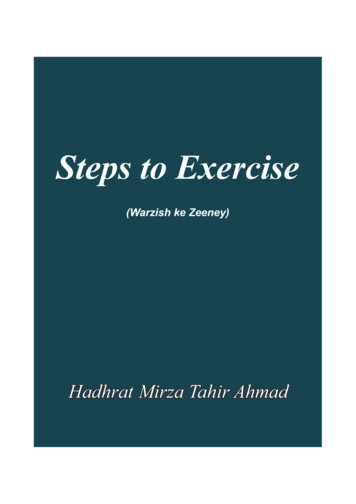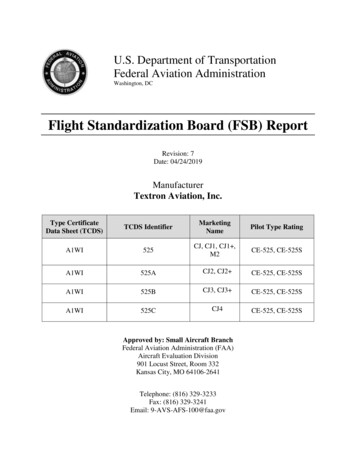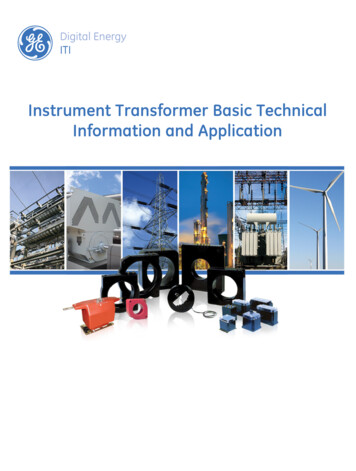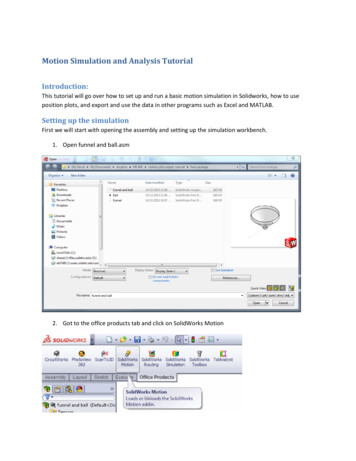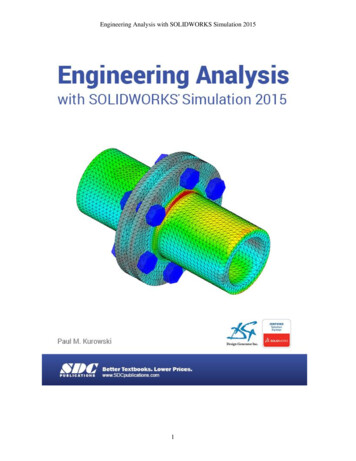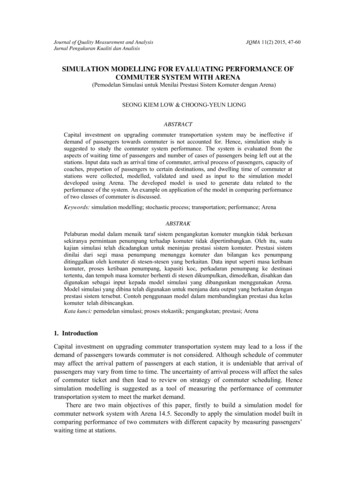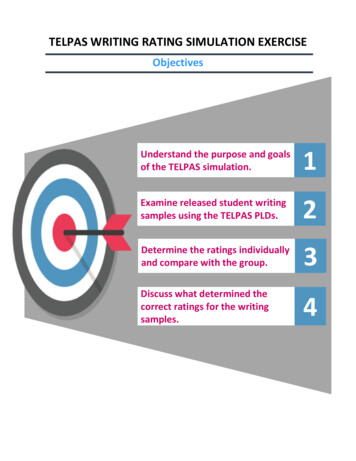
Transcription
TELPAS WRITING RATING SIMULATION EXERCISEObjectivesUnderstand the purpose and goalsof the TELPAS simulation.1Examine released student writingsamples using the TELPAS PLDs.2Determine the ratings individuallyand compare with the group.3Discuss what determined thecorrect ratings for the writingsamples.4
TELPAS WRITING RATING SIMULATION EXERCISETest Coordinator Planning The purpose for completing the simulation exercise is to provide an opportunity for teachers topractice rating writing samples using the Proficiency Level Descriptors (PLDs) before calibrating. The goal is for all teachers to pass calibration and not require a second rater. They will work independently, then collaborate to discuss their ratings. It should take 1.5 hoursusing 2-4 released writing samples and five minutes discussion time for each. Choose writing samples from the Annotated Examples of Student Writing released by TEA. Theratings and justifications for each sample are identified. Discuss the Do’s and Don’ts checklist if time permits.Before you schedule the exercise, decide on the following items:Will the teachers complete the exercise in-person, virtual or both?Do you have a CIC, department chair or other lead teacher who would like to lead the exercise?Will you create an electronic or printed sign in sheet for attendance?How many sessions do you need to schedule?Will teachers complete the exercise before or during the session?How many writing samples will you include? – (Inform the teachers if there is a mixture of grades.)Will you include a writing sample from each rating category? - (Beg, Int, Adv, Adv-High)How will you distribute the exercise?How will you follow up with teachers who still need help before calibrating?
TELPAS WRITING RATING SIMULATION EXERCISETraining Class Instructions12Conduct your TELPAS staff training.Schedule a time to complete theTELPAS simulation.Distribute teacher packet with thereleased writing samples selectedfor your school type. (ES, MS, HS)34Explain the goals, purpose andhow to complete the exerciseusing the contents of the packet.Start the timer for the exercise.Ensure that virtual staff are engagedand follow the schedule.
TELPAS WRITING RATING SIMULATION EXERCISETraining Class Instructions cont.80%CoffeeBreak5End the on time. Offer a short breakif necessary. Check the sign-sheetfor attendance.7Discuss each sample with guidingquestions for identifying andchoosing the correct rating usingthe PLDs.Comfortable6Poll the staff to see the level ofcomfort or difficulty withcompleting the exercise.8Ensure that those with difficultieshad their questions answered andare confident to calibrate.
TELPAS Writing Sample Collections/RatingsDo’s and Don’ts X-Ensure you have completed all required trainingand calibrated.-Include samples with missing studentinformation and/or date.-Ensure that you fully understand the TELPASprocess for writing collections, raterresponsibilities and writing assembly.-Include writing samples completed prior toFebruary 8, 2021.-Choose samples that are in languages otherthan English.-Collect writing samples from basic classroominstruction that will provide an accurateassessment of the student’s proficiency level.-Select the best writing samples from differenttimes during the rating window. TELPAS ratingsare not Pass/Fail.-Choose samples that do not accurately reflectthe student’s present level.-Choose samples that contain any of the specificsnot allowed. See pages 27-28 of the TELPASRater Manual.-Choose all writing samples from a scheduled“writing day”.-If unsure, seek feedback about how to determinea student’s correct proficiency rating (ex:Advanced vs. Advanced High) before calibrating.-Submit collections to the verifier.-Complete a Cover Sheet for each student.-Rate writing collections and assign an overallrating.-Submit completed and signed rating roster to TC.-Rate a student’s writing collection withoutpractice and full understanding of the PLDs.
Dallas ISD School NameTELPAS WRITING RATING SIMULATION EXERCISESPRING 2021Name:Date:Grade:
TELPAS WRITING RATING SIMULATION EXERCISEResources and Instructions1. Resources: Student worksheet TELPAS PLD reference sheet Released writing samples (i.e. – Beginner, Intermediate, Advanced, Advanced High) Notes page TELPAS Online Basic Training2. Staff schedule: Attend the meeting session assigned by your Campus Test Coordinator. Report to the meeting on time. – (The meeting may be in-person or virtual.) Sign in. - (The sign-in sheet may be electronic or printed.)3. Instructions for completing the exercise: (10 minutes for each sample) Review the selected writing prompts. Evaluate each writing prompt using the TELPAS PLDs. Enter your rating on the student worksheet. Make notes to justify your rating during group collaboration. Participate in the group discussion. Clarify your understanding, if you chose the incorrect rating.4. TELPAS Reminders: Writing samples assigned on or after February 8 may be included. TELPAS assessment window: February 8 – April 22 TELPAS calibration window: February 8 – February 19 Remember to download and save a copy of your certificate of completion after calibrating. Sign the oath of test security, and return it to your Campus Test Coordinator. TELPAS Rater manual
Student sample #1: Grade 2
Student sample #2: Grade 3
RESOURCES
ELPS-TELPAS Proficiency Level DescriptorsGrades 2–12 WritingBeginningIntermediateBeginning English learners(ELs) lack the English vocabularyand grasp of English languagestructures necessary to addressgrade-appropriate writing tasksmeaningfully.Intermediate ELs have enoughEnglish vocabulary and enoughgrasp of English languagestructures to address gradeappropriate writing tasks in a limitedway.These students: have little or no ability to use theEnglish language to express ideasin writing and engage meaningfullyin grade-appropriate writingassignments in content areainstruction lack the English necessary todevelop or demonstrate elementsof grade- appropriate writing (e.g.,focus and coherence, conventions,organization, voice, anddevelopment of ideas) in EnglishTypical writing features at this level: ability to label, list, and copy high-frequency words/phrases andshort, simple sentences (or evenshort paragraphs) based primarilyon recently practiced, memorized,or highly familiar material; this typeof writing may be quite accurate present tense used primarily frequent primary language features(spelling patterns, word order, literaltranslations, and words from thestudent’s primary language) andother errors associated with secondlanguage acquisition maysignificantly hinder or preventunderstanding, even for individualsaccustomed to the writing of ELsThese students: have a limited ability to use theEnglish language to express ideasin writing and engage meaningfullyin grade-appropriate writingassignments in content areainstruction are limited in their ability to developor demonstrate elements of gradeappropriate writing in English;communicate best when topics arehighly familiar and concrete, andrequire simple, high-frequencyEnglishTypical writing features at this level: simple, original messagesconsisting of short, simplesentences; frequent inaccuraciesoccur when creating or taking risksbeyond familiar English high-frequency vocabulary;academic writing often has anoral tone loosely connected text with limiteduse of cohesive devices orrepetitive use, which may causegaps in meaning repetition of ideas due to lack ofvocabulary and language structures present tense used most accurately;simple future and past tenses, ifattempted, are used inconsistentlyor with frequent inaccuracies descriptions, explanations, andnarrations lacking detail; difficultyexpressing abstract ideas primary language features anderrors associated with secondlanguage acquisition may befrequent some writing may be understoodonly by individuals accustomed tothe writing of ELs; parts of thewriting may be hard to understandeven for individuals accustomed tothe writing of ELsAdvancedAdvanced ELs have enoughEnglish vocabulary and commandof English language structures toaddress grade- appropriate writingtasks, although second languageacquisition support is needed.Advanced HighAdvanced high ELs have acquiredthe English vocabulary andcommand of English languagestructures necessary to addressgrade-appropriate writing taskswith minimal second languageacquisition support.These students:These students: are able to use the English are able to use the Englishlanguage, with second languagelanguage, with minimal secondacquisition support, to expresslanguage acquisition support, toideas in writing and engageexpress ideas in writing and engagemeaningfully in grade-appropriatemeaningfully in grade-appropriatewriting assignments in content areawriting assignments in content areainstructioninstruction know enough English to be able know enough English to be ableto develop or demonstrateto develop or demonstrate, withelements of grade-appropriateminimal second languagewriting in English, althoughacquisition support, elements ofsecond language acquisitiongrade-appropriate writing insupport is particularly needed whenEnglishtopics are abstract, academicallyTypical writing features at this level:challenging, or unfamiliar nearly comparable to writing ofnative English-speaking peers inTypical writing features at this level: grasp of basic verbs, tenses,clarity and precision with regard togrammar features, and sentenceEnglish vocabulary and languagestructures, with occasionalpatterns; partial grasp of moreexceptions when writing aboutcomplex verbs, tenses, grammarfeatures, and sentence patternsacademically complex ideas, emerging grade-appropriateabstract ideas, or topics requiringvocabulary; academic writing haslow-frequency vocabularya more academic tone occasional difficulty with use of a variety of commonnaturalness of phrasing andcohesive devices, although someexpressionredundancy may occur errors associated with second narrations, explanations, andlanguage acquisition are minor anddescriptions developed in someusually limited to low-frequencydetail with emerging clarity; qualitywords and structures; errors rarelyor quantity declines when abstractinterfere with communicationideas are expressed, academicdemands are high, or lowfrequency vocabulary is required occasional second languageacquisition errors communications are usuallyunderstood by individuals notaccustomed to the writing of ELs
Notes:
Annotated Examplesof Student WritingThe following writing collections are from ELLs in grades 2, 3, 5, 8, and high school. Thecollections, which come from around the state, show how students at the various proficiencylevels respond to writing tasks such as narratives, personal descriptions and reflections, andacademic writing in mathematics, science, and social studies.When evaluating the English language proficiency of second language learners, it is importantto know how well students communicate about everyday, familiar topics and narrate in detailabout past events. It is also important to know how well they handle complex linguistic demandsassociated with, for example, explaining a scientific or mathematical process, defending apoint of view, or writing a reflective piece about an abstract topic. The annotated writingcollections in this section will help raters understand how to rate each student in a holisticmanner after reading their responses to a variety of writing tasks.After reviewing the annotated writing collections, training participants will individually practicerating student collections in preparation for the online qualification process.
Student 1Grade 2Advanced High
ANNOTATIONStudent 1Grade 2This student exhibits an advanced high level of second language writing proficiency at thesecond grade level. This collection contains writing about the student and his or her family aswell as writing about science, math, and other school subjects.In paper 1, the student presents the step-by-step process of planting a seed. The student showsthe level of English needed to relate the experiment in a grade-appropriate manner. In thesecond sample, which is based on a picture stimulus, the student explains the things that areimportant to have on a camping trip. This paper shows the student’s ability to express himselfin a manner nearly comparable to native English-speaking peers in terms of clarity andspecificity of vocabulary.Papers 3–6 are reflective pieces about the student and his or her family. In these pieces thestudent shows the ability to write with clarity and ease about familiar topics. The student alsoexhibits the ability to use complex sentence structures (He thinks my bike is his bike but I saythat it’s my bike; my dad some times he takes us walking all the wai home untile the bus comes;we also have a big play groun to play when we finish all our work and test or math or languagearts and social studies).In paper 7, the student is able to communicate his or her goals in social studies using complexsentences (I want to get better at my grades especialy Social studies because I got a bery lowgrade). In paper 8, the student explains a challenging mathematical concept (rounding to thenearest ten). Although there are some issues with the clarity of the explanation, the type ofexplanation provided would not be uncommon in native English-speaking peers at the secondgrade level.The student’s spelling patterns and other writing conventions are consistent with those ofsecond grade peers, with occasional exceptions when the academic demands are high, or lowfrequency words are used.Overall, this writing collection demonstrates the ability of a second language learner who hasacquired the English vocabulary and language structures necessary to address second gradewriting tasks with minimal support.
Student 1Grade 2Paper 1
Student 1Grade 2Paper 2
Student 1Grade 2Paper 3
Student 1Grade 2Paper 4
Student 1Grade 2Paper 5
Student 1Grade 2Paper 6
Student 1Grade 2Paper 7
Student 1Grade 2Paper 8
Student 2Grade 3Beginning
ANNOTATIONStudent 2Grade 3This student exhibits a beginning level of second language writing proficiency in English.His collection contains five writing assignments on a number of topics covering a variety ofacademic subject areas. Overall, the student shows little or no ability to address gradeappropriate writing tasks meaningfully.Throughout the collection, the student’s lack of English vocabulary and English languagestructures significantly hinder his ability to communicate in English. The student shows thathe knows some recently practiced, high-frequency words and phrases, but he does not yet knowenough English to connect ideas and convey them in short, simple sentences. The studentfrequently uses his primary language to express himself and relies on the phonetics of hisprimary language to spell even very common English words (may for “my,” leero for “little,” dafor “the”). Even individuals accustomed to the writing of ELLs are unable to understand muchof what he tries to communicate.The writing features demonstrated by this student are consistent with the beginning stages ofsecond language acquisition.
Student 2Grade 3Paper 1
Student 2Grade 3Paper 2
Student 2Grade 3Paper 3
Student 2Grade 3Paper 4
Student 2Grade 3Paper 5
Student 3Grade 5Intermediate
ANNOTATIONStudent 3Grade 5This student exhibits an intermediate level of second language writing proficiency. She is ableto convey original messages in sentences and use simple, high-frequency English to write aboutfamiliar topics.This student has enough grasp of English vocabulary and language structures to convey herideas in writing, although frequent second language acquisition features are present. Herwriting is characterized by use of primary language phonetics to spell English words, whichmay make some of her writing hard to understand for individuals not accustomed to ELLwriting. She frequently uses present tense when attempting to narrate about past events (paper1). Additionally, in papers 3 and 4 her writing is repetitious in places, which often occurs whenELLs lack the English vocabulary and facility with language structures to develop and expressideas in detail. These features typify the intermediate stage of second language writingproficiency.While this student’s heavy reliance on primary language spelling patterns is indicative of theearly intermediate stage of English writing development, there is evidence of oralcommunication skills that may be beyond the early intermediate stage. This student clearly hasmore than little or no ability to address grade-appropriate writing tasks in English, so she isbeyond the beginning level of writing proficiency. Overall, her writing is consistent with theintermediate level. Her reliance on primary language spelling patterns and other secondlanguage acquisition features cause her to engage in grade-appropriate writing tasks in alimited way.
Student 3Grade 5Paper 1
Student 3Grade 5Paper 2
Student 3Grade 5Paper 2, continued
Student 3Grade 5Paper 3
Student 3Grade 5Paper 4
Student 3Grade 5Paper 5
Student 4Grade 8Intermediate
ANNOTATIONStudent 4Grade 8This student displays an intermediate level of second language writing proficiency. While thestudent produces a considerable amount of writing, the writing is characterized by frequentprimary language features and errors associated with second language acquisition.In papers 1 and 2, the student draws upon vocabulary from mathematics and science lessons toattempt to engage in the writing tasks. The use of content area resources may make it appearthat a student knows more English than is actually the case. In both papers, the student restatessteps followed in math or science assignments and does so with accurate spelling and clearorganization. The student’s ability to express original ideas is limited, however, and primarylanguage features (method scientific, importants investigations, verificate) and phrasing(Today in the math class, After of did, To do an investigation is necessary make the steps) areindicative of literal translating.In papers 3 and 4, the student describes himself, a friend, and a picture of relatives. In bothsamples, the student demonstrates the ability to write in an original way using high-frequencyEnglish vocabulary and short, simple sentences, though primary language features andgrammatical inaccuracies are frequent (my eyes are bigs; mys tooths are small; in their backare a table and a sofa and a mallet in the table). The student’s difficulty with English prepositionsmay impede meaning for individuals not accustomed to working with English languagelearners.In paper 5, the student writes a personal narrative about accidentally going to school onSaturday. The student’s grasp of basic tenses and basic grammar construction is emerging butstill quite inconsistent (I went to the school but my calendar mark Saturday, I get up and Idon’t knew, beginning to laughed of my), which is characteristic of the intermediate stage ofsecond language development. Note that high-frequency past tense verbs such as “was” and“were” are easily memorized and don’t necessarily show an ELL’s overall grasp of past tenseconstructions. In addition, in papers 3 through 5, the student’s writing is loosely connectedwith limited and repetitive cohesive devices (and, because).Overall, the student demonstrates the ability to address grade-appropriate writing tasks in alimited way. The student is able to write on familiar topics using short, simple sentencescharacterized by frequent features of second language development.
Student 4Grade 8Paper 1
Student 4Grade 8Paper 2
Student 4Grade 8Paper 3
Student 4Grade 8Paper 4
Student 4Grade 8Paper 5
Student 5High SchoolAdvanced
ANNOTATIONStudent 5High SchoolThis student displays an advanced level of second language writing proficiency. He showsenough English vocabulary and command of English language structures to address gradeappropriate writing tasks with second language acquisition support.The student writes about a variety of academic topics with emerging grade-appropriatevocabulary and an overall grasp of English language structures, though there are more thanminor or infrequent second language acquisition errors.This student’s collection may be rated too high or too low by individuals who do not adhere tothe PLDs in the rating process. Focusing too narrowly on inaccuracies related to verb use andother grammar features may sway a person toward a rating that is too low. On the other hand,being impressed by this student’s thoughtful ideas, organizational skills, and academic tonemay suggest good academic preparation, which may sway a person toward a rating that is toohigh.This student is clearly beyond the intermediate level because he is not limited in his ability tofulfill grade-appropriate writing tasks. He has not yet reached the advanced high level, though,because his writing does not yet show the need for only minimal second language acquisitionsupport.This student fits the advanced level profile. He is able to address grade-appropriate writingtasks but still needs ongoing specialized instruction to address his second language acquisitionneeds.
Student 5High SchoolPaper 1
Student 5High SchoolPaper 2
Student 5High SchoolPaper 3
Student 5High SchoolPaper 4
Student 5High SchoolPaper 5
Student 5High SchoolPaper 6
Student 6High SchoolAdvanced High
ANNOTATIONStudent 6High SchoolThis student exhibits an advanced high level of second language writing proficiency. Thestudent’s writing shows his ability to address grade-appropriate writing tasks with minimalsecond language acquisition support.The collection demonstrates writing that is nearly comparable to the writing of native Englishspeaking peers, although there are some instances of unnaturalness and awkward expression.The student makes some errors associated with second language acquisition, but the errors areminor and primarily limited to low-frequency words and structures, and the errors rarelyinterfere with communication.Consistent with the advanced high level PLDs, the student shows an ability to express himselfwith clarity and specificity, with occasional exceptions when he writes about academicallycomplex or abstract ideas. The quality of this writing and the precision of expression declinesomewhat in the science and math samples.Overall, the student is able to use English to express ideas and carry out grade-appropriatewriting assignments on a variety of academic topics with minimal second language acquisitionsupport. This student demonstrates the level of English proficiency needed to enable him toparticipate in editing activities to refine areas of awkwardness and to improve writing skillsrelated more to academic achievement than second language acquisition.
Student 6High SchoolPaper 1
Student 6High SchoolPaper 2
Student 6High SchoolPaper 2, continued
Student 6High SchoolPaper 3
Student 6High SchoolPaper 3, continued
Student 6High SchoolPaper 4
Student 6High SchoolPaper 5
This student exhibits an advanced high level of second language writing proficiency at the second grade level. This collection contains writing about the student and his or her family as well as writing about science, math, and other school subjects. In paper 1, the student presents the s



